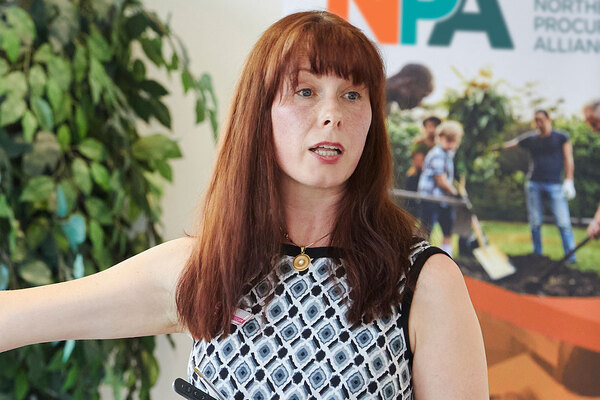Overheating: The silent crisis our systems are ignoring
As climate change delivers record-breaking summer temperatures, we face a growing risk to health and well-being, one that our own housing design has inadvertently amplified, says Izzy Henry, data analysis lead at Switchee
Our analysis at Switchee, covering over 40,000 social homes this past summer (2025), found that 14.2% of the properties we monitor were classified as ‘high risk’ for overheating at least once during the season.
These are homes where the heat index (a measure that combines air temperature and relative humidity to reflect how hot it actually feels to the human body) exceeded a dangerous 32°C for at least two hours, increasing the risk of heat exhaustion and stroke for residents.
Modelling this across all UK social homes suggests that an estimated 714,000 social housing properties experienced these unsafe conditions in 2025.
The problem is even broader when we consider moderately hot homes. Over 61% of properties fell into the ‘medium risk’ category at their peak, meaning they surpassed the 26°C threshold at which the NHS warns vulnerable groups are at risk. This affects an estimated 3 million social homes across the country in 2025.
The year-on-year increase was also significant, with the number of ‘high risk’ homes jumping by 140% from 2024 to 2025. Although we won’t necessarily see such a large increase every year, this acceleration clearly mirrors the warnings of climate and health experts. Projections show that heat-related deaths could reach 10,000 annually by 2050, with over 10,000 fatalities already recorded between 2020 and 2024.
The broader impacts of this heat are severe: it can trigger stroke, kidney failures, and heart attacks, while the psychological toll includes a doubling of suicide risk at 32°C compared to 22°C. Economically, the disruption to sleep and productivity alone costs the UK an estimated £60 billion a year.
A blind spot in our housing strategy
For decades, UK housing policy has been rightly focused on a critical goal: trapping heat to keep homes warm in winter and reduce fuel poverty. This drive, incentivised by retrofit grants like ECO4 and ORP has been important. However, an unintended consequence is that these schemes in no way mandate, support or prioritise countermeasures in the summer, making homes susceptible to overheating.
The result is a paradox playing out across the country: the very homes praised for their winter efficiency can become unbearable in July and August.
Our analysis shows that over 80% of A-rated homes experienced ‘medium or high risk’ of overheating during peak summer periods with the highest % of high risk homes being EPC B at 21%.
This focus on winter warmth continues to shape policy. For instance, the government’s new Warm Homes Plan rightly emphasises heating efficiency, but does not yet incorporate specific measures for mitigating overheating. While new building regulations (Part O) are a welcome step for new-build properties, the sector is still awaiting further comprehensive regulations to address the millions of existing homes at risk.
Even the primary standard for retrofitting, PAS 2035, highlights this disconnect between theory and reality. While the guidance rightly requires designers to assess the risk of overheating, it lacks any mandate for long-term, real-world monitoring post-installation. This creates a critical blind spot: there is no formal mechanism to measure how these homes actually perform through seasonal changes or to see if residents are truly protected during a heatwave. As a result, the industry is implementing solutions without the data to verify their true, year-round impact.
Using data to unlock investment
The immense challenge for landlords is that overheating is not a uniform problem; it is often hyper-local, affecting one side of a building or a single top-floor flat. This specificity makes it difficult to secure funding for broad interventions. However, a data-led approach is changing the game, providing the hard evidence needed to move from anecdotal complaints to successful investment bids.
A project in Salford provides a clear example. A provider there faced a considerable challenge with two large tower blocks and a limited budget. Real-time temperature data from Switchee sensors revealed the severe overheating was almost exclusively confined to the south-facing flats. This allowed them to transform their proposal from a vague appeal into a simple, understandable bid focused on a manageable number of high-risk properties, which successfully secured HNES (Heat Network Efficiency Scheme) funding to target the issue where it was most acute.
Similarly, in another case from Manchester, the challenge was to secure capital for "cooling", a concept still new to many UK funding bodies. The solution was a single, powerful chart derived from Switchee’s in-home sensors, showing 188 flats consistently exceeding safe temperature limits. Presented to the Combined Authority, this was irrefutable proof of a health risk. The evidence was pivotal, and the Authority is now in the final stages of awarding the capital funding for external shading and other essential cooling measures.
From data to dignity: making the invisible visible
Beyond unlocking funding, data empowers housing providers to manage the problem effectively and ensure residents have the understanding they need to use new equipment.
In one cutting-edge Passivhaus development, a project celebrated for its green credentials, residents were paradoxically struggling with intense heat. Again, the data told the story. It wasn’t a design flaw, this time it was a user issue; some residents were unfamiliar with the complex ventilation systems required to keep the homes comfortable.
The data logs identified exactly which homes were struggling, enabling staff to conduct targeted visits and provide tailored guidance. It’s a clear lesson that building better homes is only half the battle; we also need the tools to manage them effectively.
These examples show a clear path forward. The answer is not to abandon our insulation goals, but to be smarter. By identifying the specific properties at risk, landlords can deploy a toolkit of proven, low-energy solutions like external blinds, reflective coatings, ventilation and ensure their effectiveness and implementation with data.
Conclusion
A fundamental shift is underway in the housing sector. The evolving duty of care, enforced by Awaab’s Law, now includes hazards like extreme heat, placing it on par with mould or fire risk. This presents a challenge for housing providers caught between policies that have prioritised insulation and a future that will demand heat mitigation.
Navigating this requires proactive, intelligent management. By monitoring their housing stock with smart technology, landlords can pinpoint risks, deploy targeted solutions and build cases for required funding.
But they cannot do it alone. Ultimately, the UK is at a crossroads. We can continue to pursue a one-dimensional housing strategy, or we can build a balanced approach for year-round safety.
To achieve this, retrofit funding streams must evolve, rewarding summer resilience as much as winter efficiency. With the clarity that data provides, we have the ability to address our overheating blind spot and build the resilient, healthy, and sustainable housing future our residents deserve.



